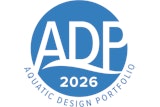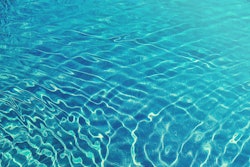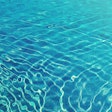Soils, topography and other natural and built features make the siting of competitive and leisure aquatic facilities tricky

There is a tendency among facility owners, when planning an outdoor aquatic center, to visualize the final product before the site selection process has been completed - and sometimes, before site selection has even begun. This is unfortunate, because the site chosen for the pool can't help but impact the final design in myriad ways. Because existing site conditions can have a substantial effect on a pool's cost, construction timeline and overall feasibility, it is essential to gather as much information as possible about the site or sites being considered, and as early in the process as possible.
A site's most apparent physical characteristic is the existence or absence of topography - that is, whether the ground is sloped or flat. Since a pool's water surface obviously is flat, one's assumption might be that the better choice for a pool would be a flat site. In reality, though, a sloped site can be preferable under certain conditions. Generally, the construction cost for a pool on a flat site will be less than the cost of the same pool on a sloped site, but the up-front cost of purchasing a flat site might more than offset the additional construction cost a sloped site requires.
To be sure, sloped sites will bring on additional costs. For example, all new pools must meet federal requirements with regard to disabled access, and a pool at a level higher or lower than parking lots or bathhouses will necessitate added costs for access ramps and railings. One benefit of a sloped site is the possibility of locating the pool equipment room beneath the pool deck, thereby eliminating the cost of constructing a pump pit (pool pumps must generally be located below the water level of the pool). With the pool equipment room beneath the pool deck, the total amount of land required for the facility is reduced. On the other side of the equation, below-grade equipment rooms have their own waterproofing, ventilation and access issues that can add to the construction cost. As with most planning issues, all these pluses and minuses must be weighed carefully before a decision is made.
A site that has both flat and sloped portions is sometimes most advantageous. The main pool might be located on the flat portion of the site, for example, with an adjacent inclined slope configured to accommodate spectator seating. Creative site planning can take advantage of site topography to eliminate tall waterslide structures by building the tower and flume into an existing hillside. And topography such as berms surrounding the pool can provide benefits in terms of wind or noise control.
Certain physical site characteristics are not readily apparent to the casual observer - for instance, the site's geology or soils condition. Even on a flat site, the characteristics of the soils can vary dramatically across the site, and these variables can make portions of it undesirable for pool construction. Take, for example, a site that once upon a time was sloped, but which was leveled off to increase its value for development. Generally speaking, native soils are naturally well compacted, but fill materials brought in to level off a site might not have been properly compacted. Unfortunately, pools are structures that are particularly sensitive to what is called differential settlement, a condition where the ground beneath a building or paving compacts over time at differing rates, so that portions of the building or paving end up out of level. Pools - particularly gutter pools - cannot function properly if even the smallest amount of differential settlement occurs in the ground beneath the pool. To avoid building a pool on land that is part native soils and part poorly compacted fill, it is necessary to hire a geotechnical engineer to drill into the ground in several areas and establish the specific differences in soils across the site.
Other soils conditions that can vary across the site and that will affect the location of a pool might include the following:
• Soil bearing capacity, a measure of how much weight the soil can handle.
• The existence of highly expansive soils, which can exert extreme pressure on a pool shell if the soil becomes wet. The forces of these soils can be eliminated by digging a much larger hole than necessary and refilling the excavation with gravel and non-expansive soils, to isolate the pool shell from the original expansive soils. Otherwise, the pool structure must be made much stronger to resist the forces, which can have a significant impact on the cost of the pool shell.
• The depth to bedrock. Digging a hole into rock is astronomically more expensive than digging into high-silt or sandy soil. On the other hand, some soils are so unstable that foundations with concrete piles have to extend all the way down to bedrock. Therefore, shallower bedrock depths are an advantage.
• The depth of the groundwater. Pools that are built extending below the high groundwater level must include a system to evacuate the groundwater before the pool can be drained for maintenance - otherwise, the pool shell can lift up out of the ground as a result of hydrostatic pressure. Also, pool construction to a depth beneath the groundwater level requires that the water be continuously pumped out of the ground to prevent the excavation from filling with water.
• In some portions of the country, seismic concerns make construction on some soils subject to the effects of liquefaction, requiring removal and replacement of soils before construction or costly foundations down to bedrock.
Another physical site characteristic is what is known as solar orientation, which considers the effects of the sun as it crosses the sky over a site, and how daily and seasonal changes affect the pool. Generally, it is desirable to maximize the benefits of the sun. Whenever the sun's rays reach the pool surface, the sun is helping to reduce the cost of heating the pool. This is known as passive solar gain. Selecting the proper site for a pool should thus consider shadows cast by hills, vegetation and even neighboring structures. North-facing slopes might thus be less desirable than other portions of a site. Sunlight, of course, is both beneficial and potentially harmful to a pool's users, and provisions for shade should be considered. Also, the problems of glare should give rise to the consideration of portable lifeguard chairs to safely guard the pool throughout the changing conditions as the sun crosses the sky each day.
Wind is another climate factor that can affect proper site selection. Persons wet after swimming experience a heightened wind-chill effect. In addition, dust and sand control can be a significant issue affecting the maintenance of pools, particularly in desert regions surrounded by vast areas of sand. Both of these effects can be minimized with features such as wind screening on chain-link fences, building fencing atop a short wall, or utilizing building or perimeter walls to shield the pool area from wind.
Existing or future vegetation on a site can benefit a pool by providing wind screening (as well as shade). However, the maintenance cost of removing leaves and debris from the pool should be considered. Landscape design should carefully consider proper plant species, such as selecting non-flowering or non-fruitbearing varieties of trees.
Views of the area surrounding the site might also be a consideration, as well as views into the pool area, which brings up issues of swimmers' privacy versus showcasing the facility to maximize usage. Many recreation facilities are planned to promote views between distinct activity areas, thereby creating a more stimulating environment for all facility users.
In addition to a site's natural conditions, built-environment issues must also be considered when selecting the proper site for a pool. The existing infrastructure is, of course, extremely important, beginning with availability of utilities (both on- and off-site). Pool filter backwash requirements must be evaluated in terms of the capacity of the off-site sewer line in the street adjoining the site. An undersized sewer service can necessitate the construction of costly on-site retention tanks or drain fields. If utilities already exist, siting should take into account proximity to existing connections, their capacity, and the cost implication to upgrade or extend existing services. Most commercial pools will require 480-volt, three-phase power, a large sewer connection or accommodation of backwash retention, a large water connection and a heat source.
The source of a site's available water supply can affect chemical system selection. The reason? A site with a well-water source might have the proper alkalinity and hardness for one chemical system, whereas the water chemistry of city water might be completely different.
Site considerations are particularly important where heat sources are concerned. The pool heater and the gas meter must often be fairly close together, depending on the pressure of the natural gas service. In addition, insulated piping to and from a physical plant, used to supply steam or high-temperature water to heat a pool, is extremely costly, and piping runs should be minimized whenever possible. Solar collectors are an environmentally conscious means of heating a pool, but the enormous amount of roof area necessary for solar collectors must be factored into the design.
Access to the site (in addition to the aforementioned disabled access) is another infrastructure consideration. Passenger drop-off for children should be located within view of the entry to the facility, and at a location where it is not necessary for pedestrians to cross roads, driveways or parking lots. A site-selection issue that can affect availability of funding is the requirement for certain urban-grant funding that the facility be located along a public transportation corridor. Service access to the pool and pool equipment room also affects pool site selection. Different pool chemical systems (gas, liquid or solid forms) have different requirements in terms of delivery and storage. Bulk liquid chemicals, for example, require that a large truck can approach within 100 feet of the chemical storage room. The pool equipment room also must be located to allow for service access for major equipment replacement.
At the same time, proximity of pools to the pool equipment room is an important consideration. Particularly with a small wading pool or spa, the distance to the equipment room must be minimized to prevent chemical system and heating system fluctuations and irregularities.
The proximity of structures on the site can affect proper site selection for a pool in other ways. A minimum horizontal distance of 12 feet between the pool edge and building rooftops or balconies - more depending on the building height - is required to dissuade persons from attempting to jump into the pool from such locations. Another infrastructure issue involves the location of rest-room or shower facilities. The distance between the pool and showers and toilets should be minimized in order to promote their use.
One final built-environment factor is the proximity of neighbors, particularly residential neighbors. The issues of noise (in particular, diving springboards and coach's whistles) and nighttime competition lighting often beg the selection of a site away from neighbors who might object to the project. Even though properly shielded light fixtures and vegetation can eliminate the effects of glare on the surrounding neighborhood, it should be understood that the latter confers no actual benefit in terms of noise control, as is sometimes thought.
Finally, there are the site issues that are driven by the actual pool activities planned, which take into consideration specific requirements for competition pools and leisure/recreation pools.
There are many factors to consider when locating a competition pool on a site. For example, a north-south orientation is generally preferable for water polo to minimize the effects of early morning and late afternoon sunlight. For diving pools, it is generally accepted that the south side of the pool is the preferred location for diving boards and platforms (so that divers don't face the sun). Whenever possible, diving apparatus should also be shielded from wind. Competition swimming has no major regard to solar orientation, except for spectator viewing. Spectator seating is preferably located so that the afternoon sun is behind the spectators for optimal viewing.
Competition pools have other requirements, as well. Their decks require minimum clear widths for meet management, as well as appropriate space allocation for athletes, teams, meet officials, referees and spectators. The high levels of lighting required for nighttime use often predicates (in addition to shielding fixtures) the need to locate the pool away from the site's perimeter. Separate spectator access to the facility might also be considered, as well as separate rest-room facilities.
Recreation/leisure pools have their own particular needs. Freeform or irregular pool shapes require a larger site area than a rectangular pool of equivalent surface area. Leisure pools' high pool occupancy means generous deck requirements, leaving space not just for persons entering and exiting the pool, but also for deck chairs. Space must be allocated for water-slide queues. Recreation pools are often designed to facilitate separation of age groups in distinct activity areas, again enlarging the pool's necessary footprint. Specialty features such as lazy rivers and wave pools have their own peculiar site requirements. For example, wave pools require elevated decks on the sides and at the end of the pool where wave generating equipment is located.
Considerations affecting proper site selection for swimming pools are complex and often contradictory. A seasoned aquatics professional can therefore be an invaluable part of the design team during this very early stage of development. Careful evaluation of the differences between possible sites can help owners choose the best location possible.




































